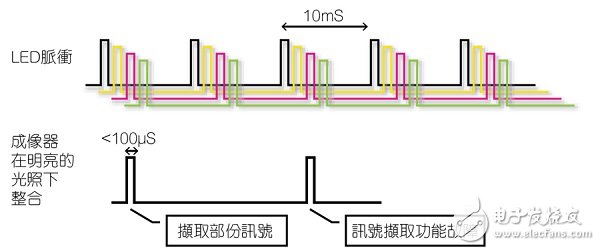LED lighting has brought many improvements to the car and road signs, but it also poses challenges for vision-based driver assistance systems such as traffic sign recognition, automatic braking and night vision. . .
LED lighting technology and vision-based advanced driver assistance systems (ADAS) each offer significant advantages in their specific areas. The intersection is that vision-based systems need to accurately determine the state of the LED lights. The flashing of the lamp is challenging for reliable identification.
Two important trends have changed the look and feel of today's cars. In the cockpit, ADAS moves from simple parking sensors to automatic braking to help drivers meet the increasingly complex challenges of maintaining safety and complying with regulations. On the outside, LED exterior lighting has inspired a variety of new styles to enhance sales appeal and strengthen brand image. However, the attractiveness of LED lighting is not limited to the body. More and more LEDs are used for road signs, from traffic lights at intersections to signs on both sides of the road, highway notices and emergency signals.

LED technology has gradually penetrated into the automotive sector, giving automakers and under-pressed highway authorities the advantage of controlling energy and maintenance costs.
LED-based traffic intersections consume far less power than traditional luminaires containing incandescent bulbs. According to the authorities that have converted the crossroads to LED lights, the electricity cost in the area has been saved by about 60-70%. A number of well-known LED traffic loyalty manufacturers have also pointed out that the latest luminaires show more than 90% energy efficiency than incandescent bulbs, and are more than 15% more energy efficient than previous generation LED lamps. In addition, LED lamps can last up to 10 years, while incandescent bulbs are estimated to be one year. This significantly reduces signal maintenance and eases traffic blockage.
For a large town, the utility and maintenance costs that can be saved from the lifecycle of the luminaire can be as high as millions of dollars.
The LED exterior lighting of the car starts from the taillights and the directional lights, and gradually improves toward the daytime running lights in front of the vehicle as the performance and brightness of the white LEDs are fully improved. In terms of the automotive industry, superior reliability is a major advantage of LED lights. The design of the lamp may make it suitable for the entire life of the car, helping to reduce design and production costs.
In addition, the compact surface mount LED emitter size gives the car designer more freedom to match the size and shape of the luminaire to create an imaginative design and meet all applicable regulatory requirements. Another advantage of LED lighting is that it is easier to electronically control, and through a more reliable semiconductor than conventional relays, it supports a variety of different operating modes, such as context-dependent flickering and sequencing.
The LED lighting prospects for vehicles and road signs are very optimistic. Related industries will continue to introduce this technology, infiltrating into more and more electronic billboard applications and a wider range of models.
In addition, automotive manufacturers and end users have been actively adopting ADAS. ADAS can be used as an important tool to help drivers react correctly to a large amount of information that often appears in front of the road, as well as assist in handling traffic conditions and improving comfort and safety.
For automakers, the innovative ADAS feature provides a highly available method of making a car stand out from the competition, as many aspects of today's cars are standardized according to regulatory requirements. Manufacturers can also use ADAS to differentiate their product lines.
Vision-based driving assistanceADAS includes a variety of systems, such as reversing parking assistance, blind spot detection, virtual mirrors, automatic emergency braking and traffic sign recognition and other vision-based systems. The number of visual 'nodes' per vehicle is expected to increase rapidly from the current one or two cameras to two digits.
According to Research and Markets' 2015-2020 Global and China Vision ADAS Industry Survey, the global automotive vision systems market is expected to reach more than 140 million camera modules per year in 2020. In the case of the United States alone, the market for the traffic identification system in 2015 was approximately $175 million and is expected to grow to $380 million by 2020.
System developers are actively responding to this market need to provide more functionality and better performance based on vision systems, especially their ability to handle a wide range of lighting conditions. For example, for areas with very bright and very dark areas of view, such as bright clouds with dark shadows, precise image capture is required, so high dynamic range (HDR) sensors have emerged.
The dynamic range of the internal scene may reach more than 120dB. ON Semiconductor's AR0231AT automotive CMOS image sensor calculates the linearized 20-bit value of each pixel by 4 exposures per cell and combines these values ​​to produce a uniform exposure image. Figure 1 shows how the AR0231AT HDR mode corrects extremes such as underexposure and overexposure in captured images.

Figure 1: Comparing non-HDR (left) and HDR mode (right) jobs
To maintain low light sensitivity while supporting high dynamic range, the sensor uses a large (3.0um) pixel that supports low and high conversion gain settings and can be set or manually adjusted by an automatic exposure control module.
The intersection of LED and ADASAutomotive lighting and road markings use more and more LEDs, presenting different challenges to the vehicle's visual sensing system. LED lighting, such as electronic billboards, may flash hundreds of times per second, which may result in artifacts in the traditional electronic shuttering mode.
This effect is the worst case when capturing a bright scene, which may cause the shutter set to be integrated for a much shorter time than the duration of the signal. Figure 2 shows how a shorter integrated sample window can cause partial or complete failure of the LED that detects illumination - this may prevent systems such as brake light detection, night vision assistance, or traffic sign recognition from functioning properly.

Figure 2: A conventional electronic shutter may malfunction when detecting a flashing light source
To prevent the effects of LED flicker, ON Semiconductor has built an advanced mechanism to reduce LED flicker (LED Flicker MiTIgaTIon; LFM) in its AR0231 sensor. The LFM uses dynamic shutter and transfer gates to extend integration time with the signal window. Figure 3 shows how LFM effectively overcomes signal recognition obstacles caused by LED flicker. In the case of a very bright scene, the LFM mode image can be superimposed on the normal video frame to fully capture the traffic signal information without saturating the CMOS sensor photodiode.

Figure 3: Signal Identification for Non-LFM (Left) and LFM (Right) Modes
The sensor also supports multi-camera synchronization over eight pixel frequencies without reducing the maximum frame rate. This enhances the performance of the ADAS system by replacing images from two or more cameras, such as virtual mirrors.
In addition, a range of features are supported to support systems that must comply with the Automotive Safety Integrated Level (ASIL)-B/ISO26262 functional safety standard, including cyclic redundancy checks for all data sent from the sensor to the host, and memory built-in self-tests. (BIST) and additional data sent by each message cell to verify the correctness of data such as row, column, and buffer contents.
Ready for the golden ageLED lighting technology and vision-based ADAS bring distinct advantages to their specific fields. The intersection is that vision-based systems need to accurately determine the state of the LED lights. In the past, flashing of lights presented challenges for reliable identification. The new electronic shutter technology is built into CMOS vision sensors that are compatible with the latest ASIL-B standards, and today it ensures reliable LED electronic signage recognition.
Polycrystalline sillicon (also called: polysilicon, poly crystal, poly-Si or also: multi-Si, mc-Si) are manufactured from cast square ingots, produced by cooling and solidifying molten silicon. The liquid silicon is poured into blocks which are cut into thin plates. The solidification of the material results into cells that contain many crystals, making the surface of the poly-Si/ mc-Si cell less perfect than its mono-Si counterpart. Due to these defects, polycrystalline cells absorb less solar energy, produce consequently less electricity and are thus less efficient than monocrystalline silicon (mono-Si) cells. Due to their slightly lower efficiency, poly-Si/ mc-Si cells are conventionally a bit larger, resulting in comparably larger PV modules, too. This factor has to be considered if space is limited. Nevertheless, the advantage of poly-Si/ mc-Si cells is that they are easier and thus cheaper to produce.
Poly Solar Cell,Solar Photovoltaic Cell,Most Efficient Solar Cell,Polycrystalline Solar Cells
Wuxi Sunket New Energy Technology Co.,Ltd , https://www.sunketsolar.com